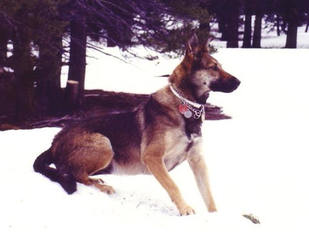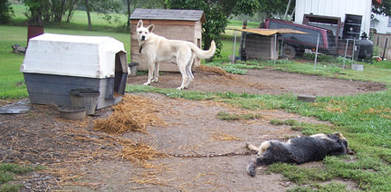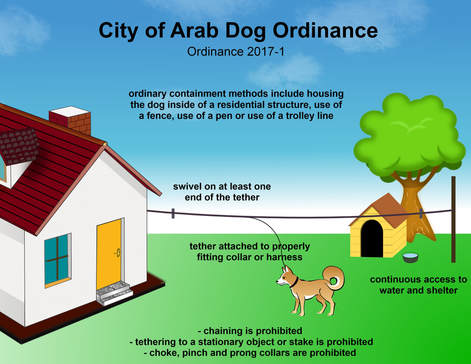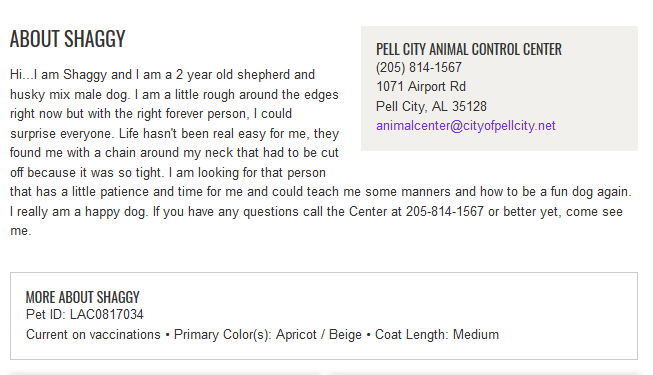|
February is Unchain a Dog Month. I have a history with chained dogs. Snake was rescued from the end of a heavy logging chain in 1992. She had spent the first two years of her life chained to a tree, living outside with no shelter and limited socialization with the people who owned her. I suspect they were afraid of her. Rich worked hard to rehabilitate her and we grew to love her dearly. She always had issues due to those early years. We had to be careful with her around other people she didn't know and around other dogs. I'm no dog psychologist, but I presume that dogs have a developmental period much like that of children and when that development is not positive, it can have long term consequences. Snake had a wonderful life with us and I'll be forever grateful Rich saved her. She would have been destroyed in a traditional animal shelter. Had she remained on that property where she began her life, it's entirely likely that she would attacked or hurt someone at some point. She was a prisoner on the end of a chain on that property for almost two years and we'll never know the psychological toll that took on her. My experiences with Snake cause me to have soft spot for chained dogs. It was years later when I learned about an organization called Dogs Deserve Better founded by Tamira Ci Thayne that I began doing slideshow work to help nonprofits. Tami had been arrested for taking a dying dog from a property in Pennsylvania who have been left to die in the end of the chain in a family's front yard. The family was never charged with cruelty or abuse, yet Tammy was arrested, criminally charged, tried and found guilty for having stolen the dog. Doogie (formerly called Jake) was not returned to the family and lived the rest of his days with love and care prior to his passing. Dogs Deserve Better later went on to purchase the former Michael Vick property in Virginia and it was transformed into the Good Newz Kennels. In 2014 the law firm from where I work got involved in defending the City of Leeds, Alabama in the civil wrongful death lawsuit brought by the widow of World War II veteran Donald Thomas. Mr. Thomas have gone out to check his mail one day and was attacked mauled and killed by two neighborhood dogs. Police arrived on scene and shot and killed the dogs. It was soon discovered that the owners of the dogs had 33 other dogs chained in their backyard inside city limits. Law enforcement authorities and city authorities knew nothing about this, but the situation was not news to the neighborhood. People had been terrorized by the dogs for years and never reported it because they really felt like nothing would be done about it. The owners of the dogs were nice and apologetic each time the dogs got loose. They were later convicted of manslaughter and criminally negligent homicide. When I interviewed the neighbors they all told me that they felt an incredible sense of guilt that they didn't complain about the dogs running loose in the neighborhood, wondering if Mr. Thomas his death could have been prevented. This was the most gruesome case I have ever worked; some things can't be unseen. As a result of my involvement in the Thomas case, I decided to seek local legislation in the city where I live to prohibit chaining of dogs and to provide for humane tethering of dogs to keep them contained. It took a while and it was a struggle to a degree. I live in a somewhat rural city with different cultures regarding how dogs are cared for. I took the subject to my city council in July of 2016 and our new ordinance was enacted in January of 2017, a point about which I'm particularly proud.The ordinance prohibits chaining, only allows for humane tethering and provides basic standards for dogs who live habitually outside. It's not perfect by any means. I would have liked it to ban perpetual penning which I also see as creating psychological problems in dogs, but in the end there was no real way to make that enforceable. When I drive around my city now I see dogs being cared for better and provided with basic standards. I would like to think that the odds of our city being the next Leeds, Alabama with a fatality attack are at least lower now that we have an ordinance and basic standards are being enforced not through the criminal provisions (violations are a misdemeanor), but primarily through public education. When the time came for us to adopt a dog recently, we ultimately chose a formerly chained dog. His name was Shaggy when we first met him. We have since changed his name to Rusty due to the color of his fur. His Petfinder listing said that he was a two year old German Shepherd Husky mix and that he have been found running loose with a chain around his neck which was so tight that it had to be cut off of him. There were other dogs we considered, but ultimately we decided to pick Rusty because we knew he would have behavioral challenges and he may be at risk of being destroyed. He's been with us for almost four months and thanks again to Rich's skills rehabilitating dogs, he's made a lot of progress. He still has some of the behaviors of a formerly chained dog, but he lives inside and is making progress with each passing month. I shudder to think what may have happened to him had he not been adopted by someone ready to rehabilitate him. He's a very sweet dog, but some adopters may lack the patience to work through his issues and it's possible he would have ended up outside again or even chained again. When I implore people to unchain dogs and to find other ways to contain them, my primary concern is about public safety. It is well documented that the dogs most apt to be involved in fatality attacks are dogs who are "resident dogs" who live outside and are not kept as family pets. Chaining dogs is opposed by every national animal welfare organization. The Humane Society of the United States, the U. S. Department of Agriculture, the ASPCA, the American Humane Association and numerous animal experts have spoken out against chaining and tethering because it is inhumane and can lead to aggressive behavior. The Centers for Disease Control (CDC) concluded in a study that the dogs most likely to attack are male, unneutered and chained.
Beyond the safety ramifications of chaining dogs, there is the obvious and very important issue of quality of life for those dogs. A dog is not a security system. If you want to use a dog to protect your home, bring the dog inside so that he or she will form bonds with your family and will consider your home his or her territory. If you have trouble house training your dog, get help. There are a variety of resources on the Internet to help you with this process and you can also interact with a trainer or behaviorist to get tips. If your dog wants to be outside or needs to be outside for parts of the day, take steps to keep him or her contained in a way which does not involve a chain. You can install a fence, use a pen (for short periods of time) or use a run or trolley line suspended between two points and property installed with stoppers at each end. Dogs who live outside for large portions of the day - or all the time - must be socialized to your family and to other people. If you don't have time to care for your dog, you really should not have a dog at all. If you still love dogs and want to have a dog in your life, consider fostering a dog for an animal shelter or a rescue group to help a dog learn new skills and to prepare that dog to be someone's beloved pet.
0 Comments
Your comment will be posted after it is approved.
Leave a Reply. |
AuthorI am an animal welfare advocate. My goal is to help people understand some basic issues related to companion animals in America. Awareness leads to education leads to action leads to change. Archives
July 2024
Categories
All
image courtesy of Terrah Johnson
|





 RSS Feed
RSS Feed